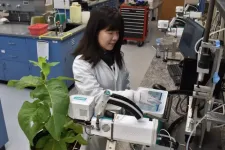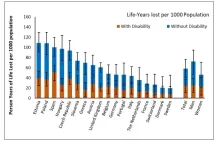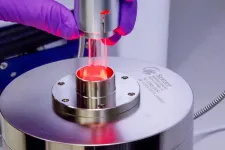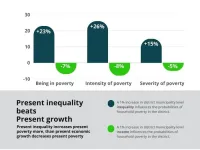(Press-News.org) FAYETTEVILLE, Ark. — As poultry companies weigh cost and efficiency with higher animal welfare standards, research comparing conventional and slow-growing broiler breeds showed that the slow-growing chickens displayed behaviors more closely associated with positive welfare.
Broilers — chickens specifically bred for meat production — are typically raised for six to eight weeks, while slow-growing broilers need up to 12 weeks to reach maturity.
Though gaining popularity in some European markets, slow-growing broilers have not seen the same market expansion in the United States, as they take longer to reach market weight than conventional broilers.
“The economic impact to the broiler industry raises the question: 'Why would you want to use a broiler that is going to eat more food, grow slower, and cost more to produce?'” said Rosie Whittle, poultry science postdoctoral fellow with the Center for Food Animal Wellbeing and the Dale Bumpers College of Agricultural, Food and Life Sciences at the University of Arkansas.
Whittle, alongside Shawna Weimer, assistant professor of poultry science and director of the Center for Food Animal Wellbeing, set out to explore this question facing industry leaders who are weighing the choice of conventional versus slow-growing broilers.
Weimer conducts research for the Arkansas Agricultural Experiment Station, part of the University of Arkansas System Division of Agriculture. The Center for Food Animal Wellbeing is a unit of the Division of Agriculture.
Their work explored the impacts of genetic strain, stocking density, and, most importantly, the comparison of physiological versus chronological age between the two genetic strains on broiler behavior. Genetic strain, or the specific breed of chicken, defines whether broilers are conventional or slow growing. Stocking density represents the number of birds in a specific area.
Researchers reviewed video recordings of the birds at specified intervals to track behaviors, such as walking, standing, and preening, which are signs of positive animal welfare. Preening is when a bird uses its beak to clean its feathers.
Their study, “Effects of genetic strain, stocking density, and age on broiler behavior,” was published in Poultry Science, an official journal of the Poultry Science Association.
Results of the study revealed that a larger percentage of slow-growing broilers were observed standing, walking, and preening, while more conventional broilers sat in a lateral posture. The effects of stocking density were minimal, so the number of birds in an area did not have a significant impact on broiler behavior.
Detailing bird behavior
Weimer pointed out that “animal welfare is quite dynamic” and emphasized that further investigations of broiler behavior should be undertaken. Whittle also stressed that their research was focused on understanding the effects of growth rate on broiler behavior, not necessarily what is best for companies or consumers.
Whittle also noted that the study focused on two types of broilers, but “all genetics companies have a different recipe for chickens.” Therefore, in tracking behavior, it is important to be aware of the possibility that “one genetic strain of broiler behaves completely different to the other,” she said.
Whittle said further research is required because “it’s always important to expand so we’re not just generalizing based on two specific genotypes.”
Co-authors of the work included Darrin Karcher and Marisa Erasmus, both associate professors of animal sciences at Purdue University. Weimer serves as corresponding author, meaning she is responsible for communication and questions about the publication.
The project was supported by Purdue University’s Department of Animal Sciences and the Center for Food Animal Wellbeing. The animal care staff at Purdue University’s Poultry Unit, Olivia Walton, Heidi Rinehart, and Nathan Griffith also contributed to the work.
To learn more about the Division of Agriculture research, visit the Arkansas Agricultural Experiment Station website. Follow us on X at @ArkAgResearch, subscribe to the Food, Farms and Forests podcast and sign up for our monthly newsletter, the Arkansas Agricultural Research Report. To learn more about the Division of Agriculture, visit uada.edu. Follow us on X at @AgInArk. To learn about extension programs in Arkansas, contact your local Cooperative Extension Service agent or visit uaex.uada.edu.
About the Division of Agriculture
The University of Arkansas System Division of Agriculture’s mission is to strengthen agriculture, communities, and families by connecting trusted research to the adoption of best practices. Through the Agricultural Experiment Station and the Cooperative Extension Service, the Division of Agriculture conducts research and extension work within the nation’s historic land grant education system.
The Division of Agriculture is one of 20 entities within the University of Arkansas System. It has offices in all 75 counties in Arkansas and faculty on three system campuses.
The University of Arkansas System Division of Agriculture offers all its Extension and Research programs and services without regard to race, color, sex, gender identity, sexual orientation, national origin, religion, age, disability, marital or veteran status, genetic information, or any other legally protected status, and is an Affirmative Action/Equal Opportunity Employer.
END
Growth rates of broilers contribute to behavior differences, shed light on welfare impacts
Slow-growing broilers exhibited behavior more linked to positive welfare than conventional ones, recent study showed
2025-03-11
ELSE PRESS RELEASES FROM THIS DATE:
Nature-inspired 3D-printing method shoots up faster than bamboo
2025-03-11
Charging forward at top speed, a garden snail slimes up 1 millimeter of pavement per second. By this logic, Beckman Institute for Advanced Science and Technology researchers’ new 3D printing process speeds past existing methods — at a snail’s pace.
Researchers in Beckman’s Autonomous Materials Systems Group created “growth printing,” which mimics tree trunks’ outward expansion to print polymer parts quickly and efficiently without the molds and expensive equipment typically associated with 3D printing. Their work appears in the journal Advanced Materials.
“Humans ...
Scientists create a type of catalog, the ‘colocatome,’ of non-cancerous cells’ influence on cancer
2025-03-11
Even cells experience peer pressure.
Scientists have long studied the ins and outs of cancer cells to learn more about the disease, but they’re increasingly finding that noncancerous cells near the cancer cells exert a powerful influence over a tumor’s trajectory.
“Not all cells in a tumor are cancer cells — they’re not even always the most dominant cell type,” said Sylvia Plevritis, PhD, chair of Stanford Medicine’s department of biomedical data science. “There are many other cell types that support tumors.”
To better capture the whole picture of cells’ locations and interactions, Plevritis ...
MSU researchers use unique approaches to study plants in future conditions
2025-03-11
As major changes continue for our planet’s climate, scientists are concerned about how plants will grow and adapt.
Researchers in the MSU-DOE Plant Research Laboratory, or PRL, Sharkey lab are studying changes in plant metabolism that occur when plants are grown in high light, high CO2 (HLHC) conditions.
They found that under these conditions, plants photosynthesize more, which can lead to larger plants, and potentially larger crop yields. However, there are tradeoffs; scientists also found that plants lose carbon under these conditions, which they need to make food. This ...
More than marks: How wellbeing shapes academic success
2025-03-11
With Australia’s National Assessment Program (NAPLAN) beginning today, new research from the University of South Australia highlights a critical but often overlooked factor in student success – wellbeing.
In a world first* study of more than 215,000 students, UniSA researchers found that while standardised tests measure academic skills, different dimensions of wellbeing - emotional wellbeing, engagement, and learning readiness - can play a crucial role in performance.
Specifically, the study found that learning readiness - which includes foundational skills such as perseverance, confidence, and engagement ...
Study quantifies loss of disability-free years of life from COVID-19 pandemic
2025-03-11
Among 289 million adults in 18 European countries, more than 16 million years of life were lost from 2020 through 2022 due to the COVID-19 pandemic, according to a new study published March 11th in the open-access journal PLOS Medicine by Sara Ahmadi-Abhari of Imperial College London, UK, and colleagues.
The direct and indirect impacts of the COVID-19 pandemic on both total and disability-free years of life lost are important for policy setting and resource allocation, but they have not been thoroughly investigated.
In the new study, researchers ...
Butterflies choose mates because they are more attractive, not just easier to see
2025-03-11
A simple neural change alters mating preferences in male butterflies, aiding rapid behavioral evolution, Nicholas VanKuren and Nathan Buerkle at the University of Chicago, US, and colleagues, report March 11th in the open-access journal PLOS Biology.
Heliconius are a group of tropical butterflies known for their wide variety of wing patterns and colors, which act as a warning to predators. Because wing coloration is crucial for their survival, males have evolved a preference for females with the same wing color. But the sensory and neurological mechanisms behind these preferences are poorly understood.
Researchers ...
SwRI receives $3 million NASA astrobiology grant to study microbial life in Alaska’s arctic sand dunes
2025-03-11
SAN ANTONIO — March 11, 2025 —Southwest Research Institute (SwRI) has received a three-year, $2,999,998 million grant from NASA to identify and characterize life and its biosignatures in frozen sand dunes in Alaska, under conditions similar to dune fields on early Mars and Saturn’s moon Titan. The Assessing Regional Reflectors of Astrobiology in Kobuk dunes for Interplanetary Science (ARRAKIS) project team, which includes researchers from Brigham Young University and the University of California—Davis, seek insight into ...
Inequality destroys the benefits of positive economic growth for the poor
2025-03-11
A unique analysis of district-level data reveals why inequality is so destructive to the home consumption welfare of people living below the poverty line, especially during times of significant economic decline, such as the COVID-19 pandemic. During negative economic growth, the welfare of the poor should be the main focus area.
Research from the University of Johannesburg shows how inequality can demolish most of the benefits of positive economic growth and social grants for people living in poverty, especially during economic downturns.
The study by Prof ...
HSS presents innovative research aimed at faster recovery after knee surgery at AAOS Annual Meeting
2025-03-11
At this year’s American Academy of Orthopedic Surgeons (AAOS) annual meeting, investigators at Hospital for Special Surgery (HSS) presented several significant studies, with three focused on new ways to help patients recover faster after total knee arthroplasty (TKA), also known as knee replacement surgery.
What follows are highlights from these studies:
Limiting Use of Tourniquets During Knee Replacement Surgery Improves Patient Outcomes
Tourniquets have traditionally been used during TKA to reduce blood loss and the need for transfusions. However, a new study of almost 18,000 patients from 2019 to 2023 found that prolonged tourniquet use was linked ...
Advancing catalysis: Novel porous thin-film approach developed at TIFR Hyderabad enhances reaction efficiency
2025-03-11
Catalytic function and its efficiency play a significant role in industrial reactions, and consistent reforms are made in the methodology to enhance the large-scale synthesis of drugs, polymers, and other desired products. Available catalysts can be homogeneous, which means that they possess the same phase as the reactants and products, making them difficult to separate from the reaction mixture. On the other hand, heterogeneous catalysts are a preferred choice for such reactions because of their ease of separation and reusability.
The past decade has seen the emergence of porous ...
LAST 30 PRESS RELEASES:
University of Oklahoma researcher awarded funding to pursue AI-powered material design
Exploring how the visual system recovers following injury
Support for parents with infants at pediatric check-ups leads to better reading and math skills in elementary school
Kids’ behavioral health is a growing share of family health costs
Day & night: Cancer disrupts the brain’s natural rhythm
COVID-19 vaccination significantly reduces risk to pregnant women and baby
The role of vaccination in maternal and perinatal outcomes associated with COVID-19 in pregnancy
Mayo Clinic smartwatch system helps parents shorten and defuse children's severe tantrums early
Behavioral health spending spikes to 40% of all children’s health expenditures, nearly doubling in a decade
Digital cognitive behavioral treatment for generalized anxiety disorder
Expenditures for pediatric behavioral health care over time and estimated family financial burden
Air conditioning in nursing homes and mortality during extreme heat
The Alps to lose a record number of glaciers in the next decade
What makes a good proton conductor?
New science reporting guide published for journalists in Bulgaria
New international study reveals major survival gaps among children with cancer
New science reporting guide published for journalists in Turkey
Scientists develop a smarter mRNA therapy that knows which cells to target
Neuroanatomy-informed brain–machine hybrid intelligence for robust acoustic target detection
Eight SwRI hydrogen projects funded by ENERGYWERX
The Lundquist Institute and its start-up company Vitalex Biosciences Announces Strategic Advancement of Second-Generation fungal Vaccine VXV-01 through Phase 1 Trials under $40 Million Competitive Con
Fine particles in pollution are associated with early signs of autoimmune disease
Review article | Towards a Global Ground-Based Earth Observatory (GGBEO): Leveraging existing systems and networks
Penn and UMich create world’s smallest programmable, autonomous robots
Cleveland researchers launch first major study to address ‘hidden performance killer’ in athletes
To connect across politics, try saying what you oppose
Modulating key interaction prevents virus from entering cells
Project explores barriers to NHS career progression facing international medical graduates
Jeonbuk National University researchers explore the impact of different seasonings on the flavor perception of Doenjang soup
Two Keck Medicine of USC Hospitals named Leapfrog Top Teaching Hospitals
[Press-News.org] Growth rates of broilers contribute to behavior differences, shed light on welfare impactsSlow-growing broilers exhibited behavior more linked to positive welfare than conventional ones, recent study showed







